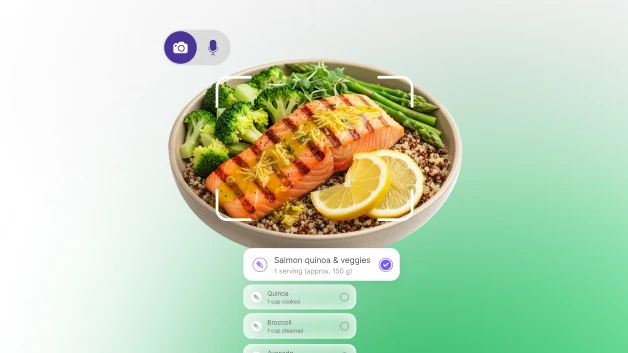Portion size guide

Portion sizes is one of the biggest nutrition hacks
This rising trend of overeating and supersized portions is stirring up quite a bit of concern. It's not just about the discomfort we might feel after a big meal, or the urge to unbutton our jeans.
The larger problem is that these excessive portions are becoming our new normal, altering our perception of what a proper meal size should be.
What's more, it's not just happening at restaurants or fast-food joints, but also in our homes. Our plates are piling higher and higher, sometimes without us even realizing it or we feel that we need to finish everything on our plate.
This pattern is concerning because it might lead to unhealthy eating habits and health problems down the line, like obesity and heart disease.

Source: CDC
While these problems get a lot of attention, another big problem that comes from constant overeating is the unnecessary stress that is put on the body’s metabolic processes.
A common misconception for many people when trying to lose weight, is trying to drastically reduce the amount of food they’re eating, which isn’t necessarily the case.
Knowing what to eat, when to eat, and how these choices affect your body plays a big part in taking back control of your metabolic health.
When you are able to assess your metabolic rate and track how your body processes the food you consume you’re better positioned to make better choices.


It's become more critical that we pay closer attention to our dietary patterns and make concerted efforts to maintain a well-rounded diet in suitable portions.
Why is Portion Size Important For Your Health?
Simply put, your body needs a specific number of calories each day to operate and sustain itself. This caloric requirement is influenced by factors such as your age, current weight, and daily physical activity, and it differs from one individual to another.
This is where portion control and size comes in.
A portion size represents a certain amount of food that provides the necessary nutrients for your body while helping you maintain a healthy weight. In a world where big servings of high-calorie foods are everywhere, super-sized meals are more common now than properly portioned meals when you eat out, and this also influences how you eat at home.
Anytime you ingest more than your body needs at any one time, the excess calories consumed (whether they be fat, carbs, or protein) are converted to, and stored as, fat. Frequent overconsumption will lead to weight gain.
Our metabolism acts as an engine transforming nutrients into energy for our body to use. The mitochondria’s job is to mitochondria convert the nutrients from the food you eat into energy. Chowing down that double burger and supersized fries tends to send your mitochondria into a frenzy because they don’t know what to do with all the extra energy.
With overeating, especially processed and high-sugar foods, fatty acids and carbs (in the form of glucose), the body soaks up the sugar - which causes a chain of changes involving hormones and metabolism that want to eat more than necessary.
However, just saying "eat less" might not be the best way to do this.
How portion control can help you lose weight
A better idea could be to encourage eating more foods that are better suited for your physiology and metabolic rate. The source of your food will help you consume and digest more healthily. For example, complex carbohydrates that are slow-absorbing will keep you feeling fuller for longer, this will help curb extra spoonfuls and snacking.
The conversation has shifted from the amount of calories you need or should restrict, to one that is grounded in ensuring you are eating the right amount of macros, at the right time of the day. By doing this, people can still enjoy plenty of quality food, but also keep their weight in check.
When you constantly overconsume, you may gain weight because you are in a caloric surplus, and your body is unable to expend all of the energy you are providing it. This results in many issues, including joint problems, high blood pressure, bad cholesterol levels, increased risks for numerous diseases, and an overall worsened quality of life.
We’re not saying counting calories don’t matter, we’re saying it’s about the source. What you eat can affect your body in different ways and may impact your ability to lose weight and keep it off. While the practice is beneficial for some, others simply don’t want to keep up with it, or it isn’t optimal for their physical or mental health.

Practical Tips for Controlling Portion Sizes
Calculate your macros
Understanding your body's specific needs is crucial to effectively manage portion sizes whether you're aiming to lose weight, gain weight, or maintain your current weight. This task can be somewhat complex and demands a degree of patience and knowledge - however - turning to personalized nutrition you can figure out the exact macro ratios suited for your body and its metabolic state.
Use smaller plates
It is a natural inclination to fill your plate, so try grabbing a smaller plate to begin with to help you practice controlling food portion sizes. There are even variations of a food portion plate that have a food portion guide design on them, so you don’t have to think!
Listen to hunger cues
Are you actually hungry? Or are you bored, stressed, or emotional? You should eat when you are hungry, but consider waiting 15 minutes before preparing yourself a meal or snack to see if you are actually feeling hungry or if it is something else.
Practice mindful eating
Because each of our metabolisms is different, the meaning of mindful eating varies from person to person. However, no matter what position your metabolism currently is in, you can still trust your body to tell you what you need. Chew slowly, enjoy your food and be mindful of what you're actually eating. For example, if you are craving something sweet, your body is actually desiring the vitamins that fruit can provide. Go ahead and enjoy a piece of fruit!
Drink More Water
Often, when we are hungry, we are actually thirsty. Before preparing yourself a meal, try drinking eight to 16 ounces of water and truly analyze how you feel afterward. Many of us are constantly dehydrated unless we carry a water bottle around with us as a reminder.
Minimize Restaurant Portions
Set yourself up for success by providing yourself with a weight loss portion size guide by requesting that half of your restaurant meal is boxed up before you are even served. This reduces the portion you are served by half, and now you have leftovers in addition to a smaller portion while eating out.
Other helpful tips for portion control from our Lumen experts:
- Enjoy preportioned snacks and meals
- When meal prepping, portion out the meals you will eat for the next few days and put the rest in the freezer, so you don’t end up having seconds
- Plan at what times during the day you will eat to avoid constant mindless snacking
- Have a food serving sizes chart on your phone or carry a printable portion sizes chart with you, so you have something helpful to reference if you are unsure about certain foods
The Benefits of Getting Your Portion Sizes Right
Benefit #1: Better blood sugar control
Overeating can cause blood sugar spikes and crashes, which can lead to feelings of fatigue and cravings for more food. Consuming controlled portions can help regulate your blood sugar levels and prevent these fluctuations.
Whole foods that are of high quality are a great place to start. Your body digests high-fiber foods more slowly — which means a more moderate rise in blood sugar. Whereas, refined carbohydrates tend to cause sharp spikes in blood sugar, and can boost blood triglyceride levels.
When you are providing the body with exactly what it needs in regard to both portion sizes and nutrients, your metabolism can run more efficiently. This efficiency supports easy maintenance of a healthy weight, reduced risk of various diseases, better energy levels, and an improved mood.
Benefit #2: Better Hunger Control
If you often overeat, your body will adjust and get used to the larger amounts of food. So, when you decide to cut down on your portion sizes, you will likely experience hunger cues because your body isn’t receiving the larger portions it was before. This can lead to you finding portion control to be difficult because you are always hungry.
However, the body is very intelligent, and your metabolism will adjust accordingly. Eventually, your metabolism will adapt and come in line with the new amount of food you are regularly eating, and this will lessen your hunger as a result.
Benefit #3: Improved Digestion
If you are constantly putting food in your body, especially food high in saturated fats and sugar, your digestive system has a hard time processing everything. This can result in symptoms like constipation, bloating, and gas. By being on a portion control diet, you make things easier on your body and have the chance to improve your gut health.
Benefit #4: Weight Management
When you overeat (consuming too many calories per day), a caloric surplus may lead to weight gain. When you’re not aware of how much you consume and the impact it has on your body, things might begin to spiral.
Conclusion
Take control of your metabolic health today by using tools that help you be aware of the current state of your metabolism and utilizing our tips for easier portion control. Once you get in a habit of doing things like using smaller plates, drinking more water, and truly being aware of your hunger cues, you will likely find yourself feeling better and losing weight more effortlessly!







 Digital download
Digital download 


